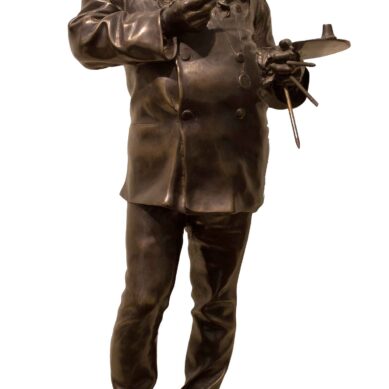You searched
Painter
Eugenio Agneni
Are you interested in the sales or the purchase of his artworks?
We buy works of this artist
and of other painters and sculptors from the 16th century to the first half of the 20th century
The Berardi gallery offers a free and without obligation service for evaluation of ancient and modern art . To find your way in the art market, very complex and full of nuances, it is better to rely on a professional consultant who can answer fast and concretely to your needs. The clarity of the answers will resolve effectively the need to estimate or sell an asset.
Contact us immediately without commitment
Answers also in 24 hours:
Eugenio Agneni
Eugenio Agneni
Eugenio Agneni was born in Sutri, a town near Rome in 1816. He moved to the capital of Latium in 1831 and was welcomed at the age of seventeen into the studio of Francesco Coghetti, who initiated him into the art of fresco and canvas painting. Eugenio Agneni produced works on various subjects, from sacred to profane, from historical to mythological.
Works from the early period have unfortunately been destroyed, such as the decoration at Villa Torlonia, in the demolished theatre of Tordinona, in the church of Trinità di Monti or at Palazzo Madama.
Eugenio Agneni: painter and patriot
In 1847 Eugenio Agneni was called upon by Pius IX to decorate the Throne Room at the Palazzo del Quirinale, when it was still a papal residence. Despite the honours bestowed on him by the Pope, Eugenio Agneni was a fervent patriot and a great supporter of Mazzini and Garibaldi. He took part in several battles, so much so that he became an officer in the army of the Roman Republic, but due to the defeat, in 1849, he was forced into exile. He took refuge first in Liguria, and then in France and England.
When in Genoa he decorated the Rocca, Solari and Piuma palaces, while when in France he participated in the decoration of some rooms in the Louvre. After leaving France, he went to London where he worked on the decoration of Covent Garden, but especially the Queen’s Rooms at Buckingham Palace.
During his stay in Paris, he participated in the Salon with The Shadows of the Great Florentine Men Protest Against Foreign Domination, a painting in which Agneni evokes great personalities linked to Florence, such as Dante, Petrarch, Boccaccio, Leonardo, Michelangelo, Savonarola and Machiavelli, with the intention of reawakening patriotic sentiment. Today, this painting is in the Galleria civica d’arte moderna e contemporanea in Turin. In this canvas, all the painter’s colouristic skills emerge, depicting the scene in this sensitive and daring nocturne with clear romantic connotations.
In 1859, he returned to an Italy that was not yet united and fought alongside Garibaldi, settling in Florence until 1871, when he was finally able to return to his beloved Rome, by then capital of the Kingdom of Italy. During his Florentine years, he decorated Palazzo Salviati and Villa Salviati in Sesto Fiorentino.
In the following years, he collaborated with the Municipality of Rome as a consultant and was responsible for the marble busts dedicated to the heroes of the Risorgimento placed at the Pincio and the so-called Gianicolo Promenade. Obviously, one of the busts, created in 1923 by Giovanni Prini, is also dedicated to Eugenio Agneni.
Eugenio Agneni’s painting between allegory and history
Eugenio Agneni exhibited at various national and international events, often recounting the present in allegorical terms in his works.
He took part in the Genoa Exhibition in 1851 with Portraits of a Family; in 1861, on his return to Florence from exile, he took part in the Exhibition in the Tuscan city with an allegorical work Return of the Dove to the Ark; and he exhibited at the Turin Exhibition of 1863 L’Italia nelle sue tre epoche (Italy in its Three Ages).
Eugenio Agneni was also a guest at some foreign exhibitions such as the Universal Exhibition in Vienna in 1873, exhibiting in a city from which independence had been gained a few years earlier some works with clear references to the past that had just passed such as Il garibaldino che ritorna al lavoro torn tornate dalle patrie battaglie and Le province italiane riunite in generale convegno si commuovono nell’veder arrivo la desiata sorella Roma. At the same event, he also exhibited The Isthmus of Suez. The Mediterranean plunging into the Red Sea bringing its riches with it, The Chief of the Priests of Venus, The Origin of the Flood. Destruction of the forests.
Eugenio Agneni died in Frascati by then ill in 1879, but five of his works were exhibited at the 1883 National Exhibition in Rome: The Submarine Telegraph, Domenichino rescued in his flight from Naples, Sacra igiene, Savonarola al letto di Lorenzo il Magnifico and The Flood.
Another posthumous exhibition in which his works are exhibited is the 1884 Turin Exhibition in which four of his paintings are mentioned: Amore infelice, Sacro all’igiene, Amor felice and Le tre epoche.
Eugenio Agneni combined in his artistic research an extraordinary compositional ability with a particular taste for portraiture. In his works it is easy to find that strong patriotic feeling in specific references to historical episodes dear to the Risorgimento, but also in allegorical scenes, metaphors of the Italian situation contemporary to him, with clear propagandistic intentions





